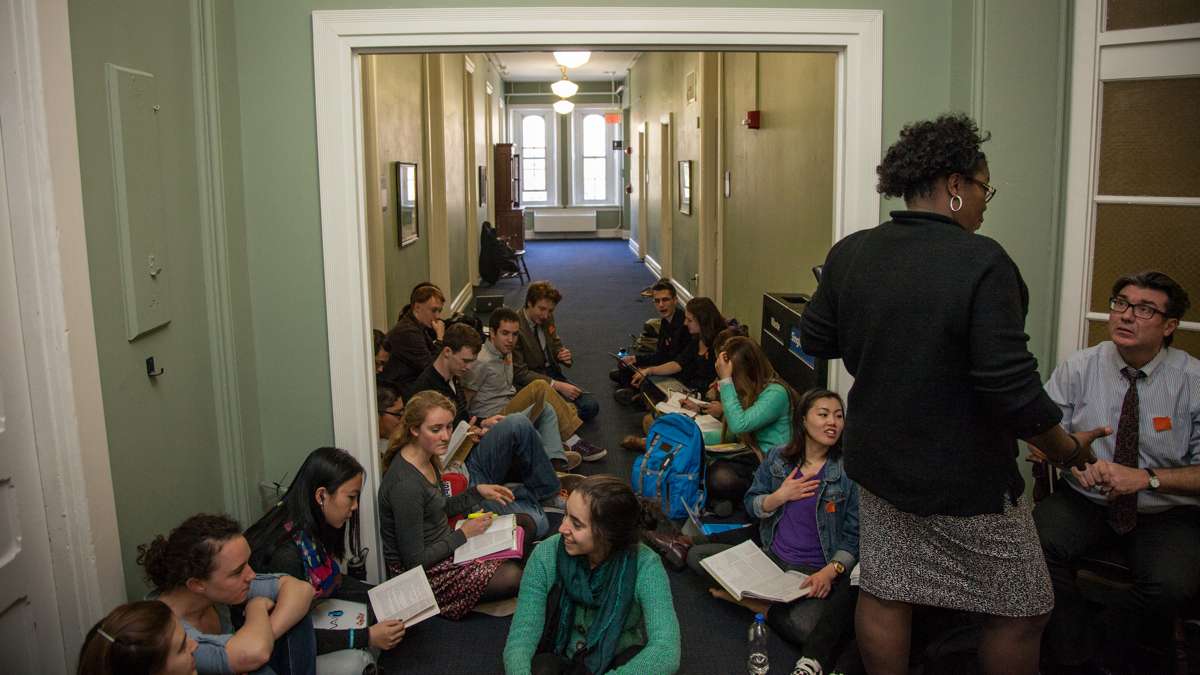Exhibit showcases Thomas Jefferson’s dedication to promoting the strength of the nation through nature
Listen-

-

-

-

-

-

-

Students gather outside of the administration offices. As of 1 p.m. no administrators had approached the students to start a dialogue. (Emily Cohen/For Newsworks)
-

Freshman education major, Josh Medel, has his picture taken by alumnae Anjali Cadambi for social media. (Emily Cohen/for NewsWorks)
-

-

-

-

-

-

-

-

-

-

In 1781, just as colonial soldiers won the battle of Yorktown, which cinched American independence from the British, Thomas Jefferson took his attention away from the Revolutionary War to write “Notes on the State of Virginia,” a catalogue of the flora and fauna of his home state, where he was serving as governor.
He made the case that the New World not only merited its own government, but its own scientists, too. It was the only book he would publish in his lifetime.
The book was a reaction to a questionnaire drawn up by the French delegate in Philadelphia, Francois Barbe-Marbois. At the time, the French – and most of Europe – did not believe America had any decent scientists, and that the study of the New World’s new discoveries would be better left to the French.
As any politician worth his salt, Jefferson re-wrote the questions so he could deliver the answers he wanted.
“Even though he began by answering Marbois’ inquiries, he also takes the opportunity to talk about how the French had said that America had no geniuses,” said historian Tara McGowan. “He said, of course, we have Washington and Franklin and Rittenhouse. He’s definitely moving beyond Virginia.”
“Notes on the State of Virginia” was intended for a European audience, only finding publication in the States after its popularity was established across the Atlantic. An original copy is included in the new exhibition at the American Philosophical Society, “Jefferson, Science, and Exploration.”
The Philosophical Society is a throwback to when what we now call science was “natural philosophy.” It was founded in 1743 by Benjamin Franklin to promote “useful knowledge.”
Jefferson was named president of the Society in 1797, making sure knowledge was not only useful but politically effective. He had a bone to pick with the French scientist, the Count de Buffon, who believed that species could become extinct. Extinction was a radical idea at the time.
“Realize this is a pre-Darwin world,” said McGowan who co-curated the exhibition. “Most people did not believe in extinction. [Buffon] believed when species moved to America where the climate was colder and wetter, they actually degenerated, becoming smaller and weaker. Which of course was a real affront to Jefferson, who wanted to prove the opposite.”
He was right, of course. To prove to Buffon just how strong and powerful American nature is, he sent a Montana moose to Buffon’s address in Paris.
But in terms of extinction, Jefferson was on the wrong side of science. Ultimately, Buffon was closer to the truth with his concept of the degeneration of species.
“Buffon’s ideas did lead to the idea of extinction,” said McGowan. “Things could degenerate to the point where they die out. He was going against the current and church at the time.”
Religion at the time did not allow for extinction. God makes everything perfect, so it does not stand to reason that He could make anything that would doe out.
In fact, they wrote a song about it. In 1800 famed scientist and artist Charles Wilson Peale gave a series of lectures about natural history at the University of Pennsylvania, accompanied with a song written by his son Rembrandt Peale, “The Beauties of Creation.”
Mark the Beauties of creationMark the harmony that reignsEach supported in its station,Age to age, unchang’d remains
“Of course, God having made everything perfect from the beginning, how could anything change?” said McGowan, who included the sheet music in the exhibition.
Which brings us to the American mastadon, a large animal distantly related to the elephant. Jefferson believed it was a mammoth, a similar but distinct species. Bones of an enormous mastodon had been discovered in Kentucky, but Jefferson needed a living one to dispute the idea of extinction.
“There was a sense that the further they pushed west, they might be able to actually find a mammoth, still living,” said Lynnette Regouby, the exhibition’s other curator. “That’s part of what they are looking for with Lewis and Clark.”
Jefferson was hungry for reports from the explorers Lewis and Clark about sightings of a mastodon. Or a mammoth. It didn’t matter which, so long as it was alive and bigger than anything they had in Europe.
“The mammoth was wonderful for Jefferson’s goals of proving that American nature is just as large and gargantuan and powerful as European nature,” said Regouby.
“And it was really important for them to think that this was a fierce creature,” added McGowan. “So they pushed the idea that it was a carnivore, until they could no longer.”
Not only has the mastodon been extinct for ten thousand years, it was an herbivore: a peaceful vegetarian. A fact, proven by fossilized teeth, which Jefferson had to eventually swallow.
Undaunted, Jefferson turned his attention to another ferocious creature discovered in the Americas. In the show is a fossil of what appears to be an enormous claw.
“This giant claw was found in Virginia and sent to Jefferson, and he was very excited because he thinks it’s part of an American lion,” said McGowan. Upon further study, scientists with the Philosophcal Society show that the claw was not designed to retract, like a cat’s. It could not have come from a lion.
“It turned out to be a giant ground sloth,” said McGowan. It was a huge disappointment for Jefferson, “especially as the sloth had not a very good meaning, being one of the deadly sins.”
Jefferson remained president of the Philosophical Society for 18 years, even during his tenure as President of the United States. He made it the main clearinghouse of scientific discovery. Anywhere in America, if you dug up something weird you would sent it to 5th and Chestnut Streets in Philadelphia to get answers, which Jefferson would then disseminate around the world.
WHYY is your source for fact-based, in-depth journalism and information. As a nonprofit organization, we rely on financial support from readers like you. Please give today.




